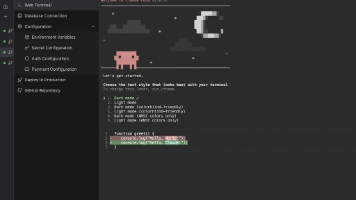ES6内置对象扩展--Array的扩展方式、String的扩展方法、Set数据结构
ES6内置对象扩展--Array的扩展方式、String的扩展方法、Set数据结构
八、ES6内置对象扩展
1、Array的扩展方式
(a)扩展运算符(展开语法):
(1)扩展运算符可以将数组或者对象转为用逗号分隔的参数序列。
let arr = [1,2,3];
//...arr //1,2,3
console.log(...arr); //1 2 3
(2)扩展运算符可以应用于合并数组。
//方法一
let arr1 = [1,2,3];
let arr2 = [4,5,6];
let arr3 = [...arr1,...arr2];
console.log(arr3); //1,2,3,4,5,6
//方法二
let arr1 = [1,2,3];
let arr2 = [4,5,6];
arr1.push(...arr2);
console.log(arr1); // [1, 2, 3, 4, 5, 6]
(3)将伪数组转换为真正的数组
var oDivs = document.getElementsByTagName("div");
console.log(oDivs);
//伪数组 HTMLCollection(6) [div, div, div, div, div, div]
var arr = [...oDivs];
console.log(arr);
//真正的数组 (6) [div, div, div, div, div, div]
(4)arr.fill() 是 ES6 的新方法。
fill() 方法用于将一个固定值替换数组的元素。
语法: array.fill(value, start, end)
参数
- value 必需。填充的值。
- start 可选。开始填充位置。
- end 可选。停止填充位置 (默认为 array.length)
填充是从 start 位置开始,到 end-1 位置结束,不包含end位置,直接修改原数组
let arr = Array.of(1,2,3,4,5);
console.log(arr.fill(0,1,2));//) [1, 0, 3, 4, 5]
(b)构造函数方法:Array.from()
(1)将类数组对象或可迭代对象转化为数组
var person = {
"0":"张三",
"1":"李四",
"2":"王五",
"length":3
}
var ary = Array.from(person);
console.log(ary); // ['张三', '李四', '王五']
(2)可以接受第二个参数,作用类似于数组的Map方法,用来对每个元素进行处理,将处理后的值放入返回的数组。
var arr = {
"0":"1",
"1":"2",
"length":2
}
var ary = Array.from(arr,item => item * 2);
console.log(ary); //[2, 4]
©实例方法:find()
(1)用于找出第一个符合条件的数组成员,如果没有找到返回undefined。
let person = [{
id: 1,
name: "张三"
},{
id: 2,
name: "李四"
}];
var ary=person.find(item => item.id == 1);
console.log(ary); //{id: 1, name: '张三'}
var ary1=person.find((item,index) => item.id == 3);
console.log(ary1); //undefined
(2)用于找出第一个符合条件的数组成员的位置,如果没有找到返回**-1**
let arr = [1,3,5,7,9,11,12];
let index=arr.findIndex(value => value > 9);
let index1=arr.findIndex(value => value > 13);
console.log(index); //5--返回的是索引--只查找第一个 所以就是11>9满足
console.log(index1); //-1
(d)实例方法:includes()
(1)表示某个数组是否包含给定的值,返回布尔值。
[1,2,3].includes(2); //数组是否包含2 true
[1,2,3].includes(4); //数组是否包含4 false
2、String的扩展方法
(a)模板字符串
ES6新增的创建字符串的方式,使用反引号定义。
let name = `张三`;
console.log(name); //张三
特点(1)模板字符串中可以解析变量。
let name = '李四';
let sayHello = `哈喽,我的名字是${name}`;
console.log(sayHello); //哈喽,我的名字是李四
(2)模板字符串中可以换行。
let person = {
name: 'zhangsan',
age: 20,
sex: '男'
};
let html = `
<div>
<span>${person.name}</span>
<span>${person.age}</span>
<span>${person.sex}</span>
</div>
`;
console.log(html);
(3)在模板字符串中可以调用函数。
const sayHello = function(){
return '哈喽';
};
let hi = `${sayHello()} 哈喽呀!`;
console.log(hi); //哈喽 哈喽呀!
(b)实例方法:
(1)startsWith()和endsWith()
- startsWith():表示参数字符串是否在原字符的头部,返回布尔值。
- endsWith():表示参数字符串是否在原字符的尾部,返回布尔值。
**startsWith()**
let str = 'hello world';
console.log(str.startsWith('hello')); //true
console.log(str.startsWith('he')); //true
console.log(str.startsWith('ell')); //false
**endsWith()**
let str = 'hello world';
console.log(str.endsWith('d')); //true
console.log(str.endsWith('rld')); //true
console.log(str.endsWith('rl')); //false
(2)repeat()
repeat()方法:表示将原字符串重复n次,返回一个新字符串。
var obj = 'x'.repeat(3); //重复3次
console.log(obj); //xxx
var str = 'hello'.repeat(2); //重复2次
console.log(str); //hellohello
3、Set数据结构
ES6提供了新的数据结构Set。它类似于数组,但是成员的值都是唯一的,没有重复的值。
Set本身是一个构造函数,用来生成Set数据结构。
const a = new Set();
console.log(a.size); //0
Set函数可以接受一个数组作为参数,用来初始化。
const b = new Set([1,2,3,4]);
console.log(b);
Set去重
//Set去重
const c = new Set(["a","b","a","b","c"]);
console.log(c); //3 {'a','b','c'}
实例方法:
- add(value):添加某个值,返回Set结构本身。
- delete(value):删除某个值,返回一个布尔值,表示删除是否成功。
- has(value):返回一个布尔值,表示该值是否为Set的成员。
- clear():清除所有成员,没有返回值。
const a = new Set();
//添加 返回Set结构本身
var arr=a.add(1).add(2).add(3);
console.log(arr); //{1, 2, 3}
var ary = [...arr];
console.log(ary); //[1, 2, 3]
//删除 返回布尔值
var del = a.delete(2);
console.log(del); //true
//是否为Set的成员 返回布尔值
var hass = a.has(1);
console.log(hass); //true
//清除所有成员 没有返回值
a.clear();
console.log(a.size); //0
遍历
Set结构的实例与数组一样,也拥有forEach方法,用于对每个成员执行某种操作,没有返回值。
const a = new Set(['a','b','c']);
a.forEach(value => {
console.log(value); //a b c
})
遍历
Set结构的实例与数组一样,也拥有forEach方法,用于对每个成员执行某种操作,没有返回值。
const a = new Set(['a','b','c']);
a.forEach(value => {
console.log(value); //a b c
})
更多推荐
 已为社区贡献1条内容
已为社区贡献1条内容









所有评论(0)